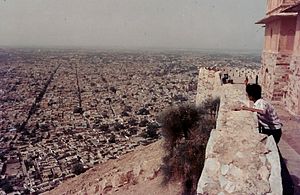
Roof Terrace of the Fort

Jaipur city from Nahargarh Fort
Nahargarh Fort stands on the edge of the Aravalli Hills, overlooking the pink city of Jaipur in the Indian state of Rajasthan. The view of the city from the fort is breath-taking. Along with Amber Fort and Jaigarh Fort, Nahargarh once formed a strong defence ring for the city. The fort was originally named Sudarshangarh, but it became known as Nahargarh, which means 'abode of tigers'. The popular belief is that Nahar here stands for Nahar Singh Bhomia,[1] whose spirit haunted the place and obstructed construction of the fort.[2] Nahar's spirit was pacified by building a temple in his memory within the fort, which thus became known by his name.[3]
Built mainly in 1734 by Maharaja Sawai Jai Singh II, the founder of Jaipur, the fort was constructed as a place of retreat on the summit of the ridge above the city. Walls extended over the surrounding hills, forming fortifications that connected this fort to Jaigarh, the fort above the old capital of Amber. Though the fort never came under attack during the course of its history, it did see some historical events, notably the treaties with the Maratha forces who warred with Jaipur in the 18th century.[4] During the Indian Mutiny of 1857, the Europeans of the region, including the British Resident's wife, were moved to Nahargarh fort by the king of Jaipur, Sawai Ram Singh, for their protection.[5] The fort was extended in 1868 during the reign of Sawai Ram Singh. In 1883-92, a range of palaces was built at Nahargarh by Sawai Madho Singh at a cost of nearly three and a half lakh rupees.[6] The Madhavendra Bhawan, built by Sawai Madho Singh had suites for the queens of Jaipur and at the head was a suite for the king himself. The rooms are linked by corridors and still have some delicate frescos. Nahargarh was also a hunting residence of the Maharajas.[7] Until April 1944, the Jaipur State government used for its official purposes solar time read from the Samrat Yantra in the Jantar Mantar Observatory, with a gun fired from Nahargarh Fort as the time signal.
Some scenes of the movie Rang De Basanti were shot at Nahargarh fort.

Breath taking view from Nahargarh Fort

Beautiful Nahargarh Fort view
References[]
- ↑ Naravane, M. S.. The Rajputs of Rajputana: a glimpse of medieval Rajasthan. http://books.google.co.in/books?id=lF0FvjG3GWEC&dq=Sudarshangarh+Jaipur&source=gbs_navlinks_s.
- ↑ "Nahargarh Fort". http://www.jaipurthepinkcity.com/forts_monuments/nahargarh_fort/nahargarh_fort.htm.
- ↑ Jaipur forts and monuments
- ↑ Naravane, M. S.. The Rajputs of Rajputana. http://books.google.co.in/books?id=lF0FvjG3GWEC&pg=PA138&dq=Sudarshangarh+Jaipur&hl=en&sa=X&ei=5flZT7zPEJDwrQf-7vWiCg&ved=0CEAQ6AEwAQ#v=onepage&q=Sudarshangarh%20Jaipur&f=false.
- ↑ Sarkar, Jadunath. A History of Jaipur. http://books.google.co.in/books?id=O0oPIo9TXKcC&dq=Nahargarh&source=gbs_navlinks_s.
- ↑ R. K. Gupta; S. R. Bakshi. Rajasthan Through The Ages: Jaipur Rulers and Administration. http://books.google.co.in/books?id=DLQeSBLpUwsC&dq=Nahargarh&source=gbs_navlinks_s.
- ↑ Jaipur Hub
Gallery[]
External links[]
| Wikimedia Commons has media related to Nahargarh Fort. |
- Website for Nehargarh Fort in Jaipur - Nahargarh Fort Information
| |||||
| ||||||||||||||||||||||||||||||||||||||||||||||||||||||||||||||
The original article can be found at Nahargarh Fort and the edit history here.







